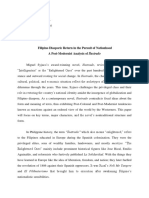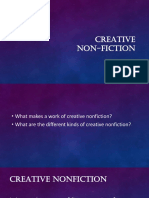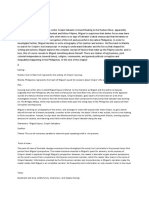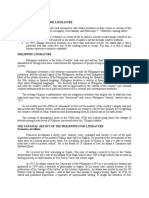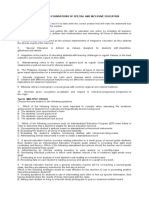0 ratings0% found this document useful (0 votes)
40 viewsGroup 7 Ilustrado Math 2 A
Group 7 Ilustrado Math 2 A
Uploaded by
Shiella BaydalThe novel follows Miguel Syjuco as he investigates the death of his mentor Crispin Salvador. Miguel interviews those who knew Salvador to learn about his life and uncover what happened to his unfinished manuscript. During his trip, Miguel encounters corruption in politics and business. He also falls for a woman named Sadie but their dinner goes poorly. While trying to rescue children during a typhoon, Miguel falls into an open manhole and dies.
Copyright:
© All Rights Reserved
Available Formats
Download as PDF, TXT or read online from Scribd
Group 7 Ilustrado Math 2 A
Group 7 Ilustrado Math 2 A
Uploaded by
Shiella Baydal0 ratings0% found this document useful (0 votes)
40 views25 pagesThe novel follows Miguel Syjuco as he investigates the death of his mentor Crispin Salvador. Miguel interviews those who knew Salvador to learn about his life and uncover what happened to his unfinished manuscript. During his trip, Miguel encounters corruption in politics and business. He also falls for a woman named Sadie but their dinner goes poorly. While trying to rescue children during a typhoon, Miguel falls into an open manhole and dies.
Original Title
Group-7-ilustrado-Math-2-A
Copyright
© © All Rights Reserved
Available Formats
PDF, TXT or read online from Scribd
Share this document
Did you find this document useful?
Is this content inappropriate?
The novel follows Miguel Syjuco as he investigates the death of his mentor Crispin Salvador. Miguel interviews those who knew Salvador to learn about his life and uncover what happened to his unfinished manuscript. During his trip, Miguel encounters corruption in politics and business. He also falls for a woman named Sadie but their dinner goes poorly. While trying to rescue children during a typhoon, Miguel falls into an open manhole and dies.
Copyright:
© All Rights Reserved
Available Formats
Download as PDF, TXT or read online from Scribd
Download as pdf or txt
0 ratings0% found this document useful (0 votes)
40 views25 pagesGroup 7 Ilustrado Math 2 A
Group 7 Ilustrado Math 2 A
Uploaded by
Shiella BaydalThe novel follows Miguel Syjuco as he investigates the death of his mentor Crispin Salvador. Miguel interviews those who knew Salvador to learn about his life and uncover what happened to his unfinished manuscript. During his trip, Miguel encounters corruption in politics and business. He also falls for a woman named Sadie but their dinner goes poorly. While trying to rescue children during a typhoon, Miguel falls into an open manhole and dies.
Copyright:
© All Rights Reserved
Available Formats
Download as PDF, TXT or read online from Scribd
Download as pdf or txt
You are on page 1of 25
Ilustrado
By: Miguel Syjuco
Today we'll discuss
AUTHOR OF THE BOOK
BACKGROUND OF THE BOOK
THEME
CHARACTERS
SUMMARY
WHAT WAS THE MESSAGE OF THE BOOK?
• Miguel Augusto Gabriel Jalbuena Syjuco
is a renowned writer for his first novel
ABOUT THE AUTHOR
Ilustrado.
In 2000, he completed his bachelor degree
from Ateneo de Manila University with a
Miguel Syjuco degree of Bachelor of Arts in English
Literature. He then pursued his terminal
degree or Masters in Fine Arts at Columbia
University. As a passionate writer he
proceeded to complete his PhD in
Literature from the University of Adelaide
in Australia.
•Syjuco is best known for his debut novel
"Ilustrado," which won the Man Asian
Literary Prize for Fiction in 2008. And
currently works as an assistant professor of
Practice, Literature, and Creative Writing
at New York University Abu Dhabi. He also
serves as a fellow at Harvard University
and an International Writer at Singapore's
Nanyang University. He plays different roles
such as journalist, panelist, fact checker
(November 17, 1976 - present) and writing partner at some of well-known
universities around the world.
Background of the Book
1. HISTORICAL LAYERS
The novel covers a broad historical
spectrum, from the Spanish colonial period
to the martial law under Ferdinand Marcos
and contemporary times. This temporal
scope allows the narrative to capture the
evolution of Philippine society, reflecting
the impact of colonization and political
upheavals.
Background of the Book
2. CULTURAL COMPLEXITY
The term "ilustrado" historically
referred to the educated elite during
Spanish colonial rule. The novel delves
into the cultural complexities arising
from this history, addressing issues of
class, education, and the clash between
traditional and modern values.
Background of the Book
3. POLITICAL CRITIQUE
"Ilustrado" subtly critiques political
corruption and power dynamics in the
Philippines, particularly during the
Marcos era. It provides insights into the
challenges faced by the nation in its
pursuit of democracy and the
consequences of political instability.
Background of the Book
4. LITERARY EXPLORATION
The novel employs a metafictional
approach, incorporating excerpts from
fictional works by Crispin Salvador, the
central character. This literary exploration
examines the role of storytelling in
shaping national identity and blurs the
boundaries between fiction and reality.
Background of the Book
5. GLOBAL PERSPECTIVE
The narrative extends beyond the
Philippines, incorporating the experiences
of the Filipino diaspora in the United
States. This global perspective reflects
the interconnectedness of Filipino
experiences with broader global issues
and the impact of migration on identity.
Themes of the Book Ilustrado
1.Identity
The novel delves into the
complexities of Filipino identity,
examining how historical events,
colonial legacies, and societal
expectations shape individuals and
communities. It explores the tension
between tradition and modernity,
the dynamics of class, and the
struggles of characters to define
themselves in the face of societal
pressures.
Themes of the Book Ilustrado
2. Politics and Corruption
"Ilustrado" provides a subtle yet
powerful critique of political
corruption in the Philippines,
particularly during the Marcos
era. It exposes the impact of
political decisions on the lives of
ordinary citizens and the
challenges faced by the nation
in its pursuit of democracy.
Themes of the Book Ilustrado
3. Literary Exploration
The novel's unique structure
incorporates fictional works within
the narrative, exploring the power
of literature to shape national
identity. It blurs the lines between
reality and fiction, prompting
readers to question the reliability
of narratives and the role of
storytelling in influencing
perceptions of history.
Themes of the Book Ilustrado
4. Global Perspective
The narrative extends beyond the
Philippines to include the
experiences of the Filipino
diaspora in the United States.
This global perspective reflects
the interconnectedness of
Filipino experiences with broader
global issues, emphasizing the
impact of migration on identity.
Characters from the Book "Ilustrado"
“Crispin Salvador”
Writer of the controversial manuscript : “The Bridges Ablaze”
Found “Dead” at the Hudson river in 2002.
Apprentice : Miguel Syjuco.
Characters from the Book "Ilustrado"
“Miguel Syjuco (the protagonist)”
Mentor: Crispin Salvador.
Went to the Philippines to investigate on Crispin Salvador’s
Death, and the whereabouts of TBA (The Bridges Ablaze)
Manuscript.
Had similarities with his Mentor.
Characters from the Book "Ilustrado"
“Grapes & Grandma”
Grandparents of Miguel.
Secondary Parents of Miguel after his parents Death.
Grapes is a narcissist, power hungry politician.
“Supports” Miguel’s writing career.
Characters from the Book "Ilustrado"
”Madison”
Overly Attached Girlfriend of Miguel. (Ex Girlfriend)
Altruistic
Has man-feet & hands.
Fed up with Crispin’s obsession on his mentor’s death.
Characters from the Book "Ilustrado"
“Sadie Gonzales”
High spirited, wild child, atenista.
Encountered Miguel at the Library “The
Enlightened”.
Miguel’s New...Lover?
Characters from the Book "Ilustrado"
“Politicians”
Pres. Ferdinand Estregan- corrupt Leader, rumored to have a sex
scandal with actress; Vita Nova.
Rev. Martin- Suspected of embezzlement in church fund.
Senator Bansamoro- Accused of bombing and Abu Sajaf
Operations/attacks.
Vita Nova- Sexy actress. Holds the “sex video” with the President.
Characters from the Book "Ilustrado"
“Skits”
Erning isip- A.M.A. student, simple minded, ignorant, and prefers
anything but PH-made.
Atenista & Lasalite- Rich friends.
Boy Bastos- E.R.’s Son.
(Girly Bastos)
Book Summary
The novel opens with a prologue, signed by “Miguel,” summarizing the
life of his mentor and former professor Crispin Salvador, a famous
Filipino writer who fled the country in 1972. A teacher at Columbia
University, he was recently found dead in New York City. While his
death has been ruled a suicide, Miguel remains convinced that he was
murdered. At the time of his death, Salvador was close to finishing a
new book, 20 years in the making, entitled The Bridges Ablaze, in which
he described “the generations-long ties of the Filipino elite to cronyism,
illegal logging, gambling, kidnapping, corruption, along with their
related component sins.” This manuscript was found to be missing from
Salvador’s possessions at the time of his death.Miguel sets out to
investigate his mentor’s death and to produce an account of his life
and work. His first clue is a single page of Salvador’s manuscript,
mentioning several names, including notable figures of the literati and
political clans of the Philippines. Someone named “Dulcinea” is also
mentioned.
Book Summary
Miguel flies to Manila to interview these people. On the plane,
he overhears fellow passengers talking about a migrant worker
named Wigberto Lakandula, whose girlfriend was murdered by
her employers. Lakandula has sworn vengeance against the
wealthy Changcos family and become a popular hero.
As he lands, Miguel witnesses an explosion at a factory. He
learns that this factory was run by PhilFirst, a corporation that
bribes politicians to overlook its appalling safety record.
Miguel interviews Salvador’s sister, Lena, who fills him in on
Salvador’s early life as a member of the Filipino elite: “Just your
typical rich family,” she explains, while a maid fans her.
Salvador, she explains, disliked their father’s lack of scruples.
Nevertheless, “You can’t govern well if you have scruples,” Lena
concludes.
Book Summary
From Lena, Miguel learns that “Dulcinea” is his mentor’s illegitimate
daughter. Lena suggests that Miguel speak to an old family friend
Miss Florentina to find out more. That night, Miguel meets up with
some old friends and goes clubbing. He takes cocaine for the first
time in many years. The next day, at a book launch, he meets and falls
for a young woman named Sadie Gonzalez. Sadie suggests that her
mother—a big Salvador fan—might have some useful information.
Miguel eagerly accepts her invitation to dinner, but it doesn’t go
well.Miss Florentina tells Miguel where to find Dulcinea. Later, at the
theatre, Miguel is due to meet Marcel Avellaneda, a political
journalist and an old friend of Salvador’s, but Marcel doesn’t arrive.
While Miguel is out clubbing with Sadie, a typhoon hits the city and
the streets are flooded. Sadie and Miguel are stranded. Miguel sees
two children floating down the road on an ice-cream truck, and he
climbs out of the car to rescue them. He falls into an open manhole
and dies.
Book Summary
The remainder of the novel is narrated by Salvador. In the first person,
Salvador describes his feelings about Miguel’s death. In the third person,
Salvador imagines that Miguel survived his fall and continued his story.
This third-person voice takes over and describes Miguel flying to “Isla
Dulcinea” to meet Dulcinea. Miguel arrives at the island. It is a
paradisiac place, and Dulcinea’s house is beautiful, isolated—and empty.
She is not there, and the manuscript boxes where Miguel had hoped to
find The Bridges Ablaze are empty. Salvador narrates the epilogue in the
first person. He recalls a morning in February, on which he learned of
Miguel’s death. Though the two men were not especially close, Salvador
found himself unable to stop thinking about Miguel’s death—resulting in
the novel that we have just read. Ilustrado serves as an introduction to
Filipino history and politics, but it is also an exploration of the writer’s
life, and the challenges faced by political artists everywhere. “Spiced
with surprises and leavened with uproariously funny moments, it is
punctuated with serious philosophical musings” (The New York Times).
Message of the Book
The main message of "Ilustrado" is to explore the complexities
of Filipino identity, history, and society. It examines how
historical events and political issues shape individual lives and
cultural identity. The book also emphasizes the importance of
literature in reflecting and challenging societal norms and
narratives. Overall, "Ilustrado" invites readers to think critically
about Filipino culture, history, and the broader global context in
which these stories unfold.
Members:
PABILLO, RALPH ANTHONY
PASILLOS, JEZIL B.
PEROLINO, MA. DIANA ROSE
RASONABLE, MICHELLE ANN
BSED MATHEMATICS 2-A
You might also like
- Key Selection Criteria 1 - 5 Luke PrengaDocument6 pagesKey Selection Criteria 1 - 5 Luke Prengaapi-3329320120% (1)
- Ang Diablo sa Filipinas: ayon sa nasasabi sa mga casulatan luma sa KastilaFrom EverandAng Diablo sa Filipinas: ayon sa nasasabi sa mga casulatan luma sa KastilaRating: 5 out of 5 stars5/5 (1)
- IlustradoDocument10 pagesIlustradoNorkhan MacapantonNo ratings yet
- Lesson 9 (Chapter 10-11) Organizational Behavior and ConflictDocument16 pagesLesson 9 (Chapter 10-11) Organizational Behavior and ConflictShinji100% (2)
- How To Speak Like A Leader in A Meeting by Lay Tina LederDocument11 pagesHow To Speak Like A Leader in A Meeting by Lay Tina LederMichael HarrilalNo ratings yet
- Academic TranscriptDocument2 pagesAcademic Transcriptapi-267735417100% (2)
- Stakeholder Post Project Evaluation FormDocument4 pagesStakeholder Post Project Evaluation FormJuan Fernando Suaza RtpoNo ratings yet
- Lit Module 7Document25 pagesLit Module 7Erica LageraNo ratings yet
- 21st LITERATURE REVIEWERDocument9 pages21st LITERATURE REVIEWERFELIPE, GLAISEN PEARL M.No ratings yet
- Module 4Document17 pagesModule 4Lian Erica LaigoNo ratings yet
- Story AnalysisDocument5 pagesStory AnalysisFloresa TahumNo ratings yet
- ASIADocument1 pageASIADianne SablayanNo ratings yet
- Ilustrado PaperDocument9 pagesIlustrado PaperYna JohanneNo ratings yet
- Creative FictionDocument22 pagesCreative FictionJhayce Christian S. Capanayan100% (1)
- 5 Paragraph CritiqueDocument2 pages5 Paragraph CritiqueIvan Liel EmmanuelNo ratings yet
- IlustradoDocument8 pagesIlustradoegan llarenasNo ratings yet
- Noli Me TangereDocument4 pagesNoli Me TangereSteve DayagNo ratings yet
- LiteratureDocument10 pagesLiteratureBreyyNo ratings yet
- EdD FLT 601 - AradorDocument5 pagesEdD FLT 601 - AradorNYLEVE HOPE DOROMALNo ratings yet
- Southeast Asian Authors and Background FINALDocument5 pagesSoutheast Asian Authors and Background FINALshaiannegaileccandelNo ratings yet
- 1720 IlustradoDocument1 page1720 IlustradoPatricia Selina HejastroNo ratings yet
- SED LIT 2 Chapter 5 ActivitiesDocument5 pagesSED LIT 2 Chapter 5 ActivitiesSylvia DanisNo ratings yet
- Module 8 THE SOUTHEAST ASIAN PROSEDocument19 pagesModule 8 THE SOUTHEAST ASIAN PROSECarie Joy UrgellesNo ratings yet
- 21 Century Objective: Edith L. TiempoDocument15 pages21 Century Objective: Edith L. Tiempojovelou marticioNo ratings yet
- Introduction To PhilippineDocument6 pagesIntroduction To PhilippineJemimah Rabago PaaNo ratings yet
- Philippine LitDocument44 pagesPhilippine LitNicole RosalesNo ratings yet
- Sple ReportDocument48 pagesSple ReportMarc Josua CagayanNo ratings yet
- Jose Garcia Villa: Tale, EtcDocument14 pagesJose Garcia Villa: Tale, EtcFaith D Villasor100% (1)
- 21st Century Literature ReviewerDocument14 pages21st Century Literature ReviewerFaith D VillasorNo ratings yet
- IlustradoDocument2 pagesIlustradoTon YoNo ratings yet
- Canonical Authors and Works of The Philippine National Artists in LiteratureDocument5 pagesCanonical Authors and Works of The Philippine National Artists in LiteratureJessica CaisipNo ratings yet
- 21st Century Literature Intro SummaryDocument36 pages21st Century Literature Intro SummaryJames Salibay80% (5)
- 10 Filipino Novels You Should ReadDocument3 pages10 Filipino Novels You Should Readrusty.otilla001No ratings yet
- Intro 21st Century LitDocument28 pagesIntro 21st Century LitAlbert Joe AbrinaNo ratings yet
- RizalDocument13 pagesRizalCamlas Tallase RoyNo ratings yet
- 21st Latin America and AfricaDocument9 pages21st Latin America and AfricaReo Klent AlawasNo ratings yet
- Philippine Literature Withstood Time and Periods and Has Evolved Through GenerationsDocument21 pagesPhilippine Literature Withstood Time and Periods and Has Evolved Through GenerationsLiam RamosNo ratings yet
- Introduction To PhilippineDocument5 pagesIntroduction To Philippinesaramina CandidatoNo ratings yet
- (M5 MAIN) 21st Century Literature From The PhilippinesDocument55 pages(M5 MAIN) 21st Century Literature From The PhilippinesAlthea Angela BulaclacNo ratings yet
- Introduction To PhilippineDocument7 pagesIntroduction To PhilippineChristine BanayatNo ratings yet
- Contemporary PeriodDocument3 pagesContemporary Periodmarsha jayNo ratings yet
- Ho1 21STDocument2 pagesHo1 21STJohn Carl B. BungarNo ratings yet
- Life and Works of Jose Garcia VillaDocument12 pagesLife and Works of Jose Garcia VillaHansen Jam von MatinagnosNo ratings yet
- National Artist of The Philippines For Literature Pres.Document32 pagesNational Artist of The Philippines For Literature Pres.jericah.aristoNo ratings yet
- San Francisco, Ocampo, Camarines Sur: Genesis Children'S Growth Academy, CorpDocument4 pagesSan Francisco, Ocampo, Camarines Sur: Genesis Children'S Growth Academy, Corpcarl austria100% (1)
- Philippine Contemporary FictionDocument8 pagesPhilippine Contemporary FictionRhea Batiller LozanesNo ratings yet
- The Contemporary PeriodDocument12 pagesThe Contemporary Periodbenedictonathan7No ratings yet
- AUTHORSDocument16 pagesAUTHORSJingle CamotesNo ratings yet
- Republic After Edsa HandoutDocument2 pagesRepublic After Edsa HandoutKevinjosh FriginalNo ratings yet
- American Colonial PeriodDocument47 pagesAmerican Colonial PeriodMarian Mahilum100% (1)
- Conditions in The 19th Century Related To The Noli Me TangereDocument3 pagesConditions in The 19th Century Related To The Noli Me TangereDan Oliver Guieb0% (1)
- Representative Texts and Author in The WorldDocument14 pagesRepresentative Texts and Author in The WorldMichael Allen RabagoNo ratings yet
- Introduction To Philippine LiteratureDocument6 pagesIntroduction To Philippine LiteratureRubelyn Mae Equipado InocencioNo ratings yet
- Pre Ito Yung 2Document3 pagesPre Ito Yung 2France MaligasoNo ratings yet
- Canonical Authors and Works of Philippine National ArtistsDocument36 pagesCanonical Authors and Works of Philippine National ArtistsJoyce Rodanillo Lovenario80% (5)
- Historical Background of Philippine Literature During The Modern PeriodDocument3 pagesHistorical Background of Philippine Literature During The Modern PeriodJayrold Balageo Madarang100% (2)
- Nestor Vicente Madali GonzalezDocument5 pagesNestor Vicente Madali GonzalezArwen TapizNo ratings yet
- Prepared by Miss Mary Katrine M. BelinoDocument51 pagesPrepared by Miss Mary Katrine M. BelinoChristian Mark Almagro AyalaNo ratings yet
- Philippine LiteratureDocument4 pagesPhilippine Literatureramon discionNo ratings yet
- Literary Reading Through The Different ContextDocument38 pagesLiterary Reading Through The Different ContextEllaNatividad100% (1)
- Quarter 1 Lesson 1Document7 pagesQuarter 1 Lesson 1ConnieRoseRamosNo ratings yet
- 21st Century Lesson2Document21 pages21st Century Lesson2Lorianne Arcueno100% (1)
- The Legacy Left Behind by RizalDocument8 pagesThe Legacy Left Behind by RizalKevin BaltazarNo ratings yet
- Study Guide for Decoding A Catcher in the Rye: With Typical Questions and AnswersFrom EverandStudy Guide for Decoding A Catcher in the Rye: With Typical Questions and AnswersNo ratings yet
- Resume of Mohammad Saiful IslamDocument3 pagesResume of Mohammad Saiful IslamTanVir HossainNo ratings yet
- Work-From Home Accomplishment Template Department: School Department Head/Coordinator PrincipalDocument6 pagesWork-From Home Accomplishment Template Department: School Department Head/Coordinator PrincipalAntonia GuiribaNo ratings yet
- Module 3 - Lesson 2Document17 pagesModule 3 - Lesson 2Daphne YapNo ratings yet
- Definition of Quality: Difference Between Qa and QCDocument7 pagesDefinition of Quality: Difference Between Qa and QCDenisho DeeNo ratings yet
- Accomplishment Report Phil IriDocument4 pagesAccomplishment Report Phil IriPunong Grande NHS Banga NHS Annex (R XII - South Cotabato)No ratings yet
- Assessment 1 Research III 4th QuarterDocument1 pageAssessment 1 Research III 4th QuarterBen Joseph VergaraNo ratings yet
- The Deaf and LanguageDocument18 pagesThe Deaf and LanguageGita Ayu Pradira100% (1)
- (Final Ques) To Study The Impact of Hybrid Work Model On The Employee Performance and Organization Development in It SectorDocument3 pages(Final Ques) To Study The Impact of Hybrid Work Model On The Employee Performance and Organization Development in It SectorGokula KrishnanNo ratings yet
- Model CV Curriculum Vitae European EnglezaDocument3 pagesModel CV Curriculum Vitae European EnglezafecliNo ratings yet
- Data Mining - Lecture 1Document23 pagesData Mining - Lecture 1Ankush JindalNo ratings yet
- ECS171: Machine Learning: Lecture 1: Overview of Class, LFD 1.1, 1.2Document29 pagesECS171: Machine Learning: Lecture 1: Overview of Class, LFD 1.1, 1.2svwnerlgwrNo ratings yet
- Specialities in NursingDocument59 pagesSpecialities in NursingPriya SinghNo ratings yet
- Learner's Training RequirementsDocument27 pagesLearner's Training Requirementsdaisy mae asoy50% (2)
- Tarea 1 English 3 ElianniDocument4 pagesTarea 1 English 3 ElianniMiguel LopezNo ratings yet
- Adchoice S: Meaning of School LifeDocument3 pagesAdchoice S: Meaning of School LifeMariaNo ratings yet
- Breakthrough Plus Level 3 SB Unit 10Document6 pagesBreakthrough Plus Level 3 SB Unit 10paco castrejon100% (2)
- Assessment of Mother's Knowledge Regarding Management of Children With Diabetes Mellitus Type 1Document10 pagesAssessment of Mother's Knowledge Regarding Management of Children With Diabetes Mellitus Type 1Rushikesh JadhavNo ratings yet
- Chapter 2 PolynomialDocument5 pagesChapter 2 PolynomialDøomNo ratings yet
- Let's Start!: ContentDocument5 pagesLet's Start!: ContentSaritaPilozoCamposanoNo ratings yet
- Harmonious AssertivenessDocument8 pagesHarmonious AssertivenessVioleta GloriaNo ratings yet
- Curriculum Vitae: A. Personal IdentitiesDocument6 pagesCurriculum Vitae: A. Personal IdentitiesAguiaXimenesNo ratings yet
- Curriculum Materials NotesDocument14 pagesCurriculum Materials NotesFlora Niña Remaneses ReyNo ratings yet
- Mid Term Examination in Foundations of Special and Inclusive EducationDocument4 pagesMid Term Examination in Foundations of Special and Inclusive EducationYnaNo ratings yet
- Chapter 1-3 (Research Proposal)Document24 pagesChapter 1-3 (Research Proposal)Thitinun LekklaNo ratings yet
- Plan Clasa 3Document6 pagesPlan Clasa 3LauraBercaru100% (1)












